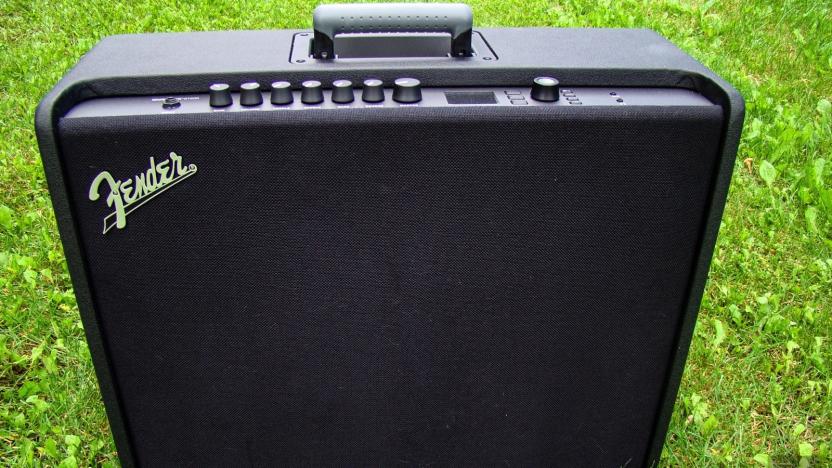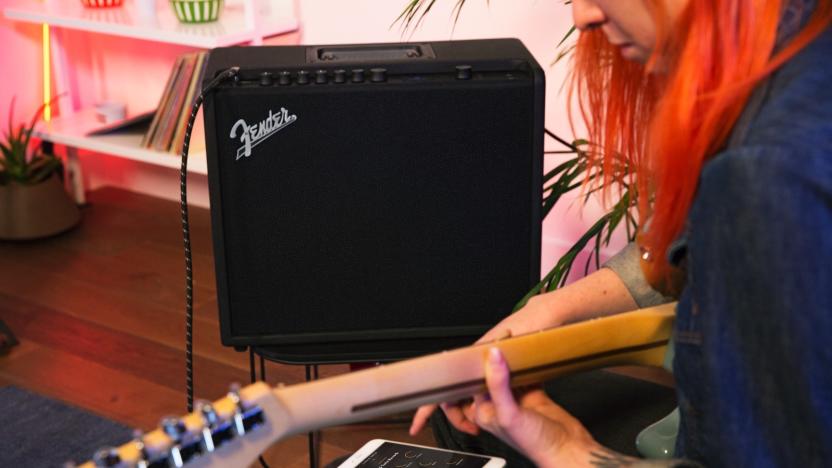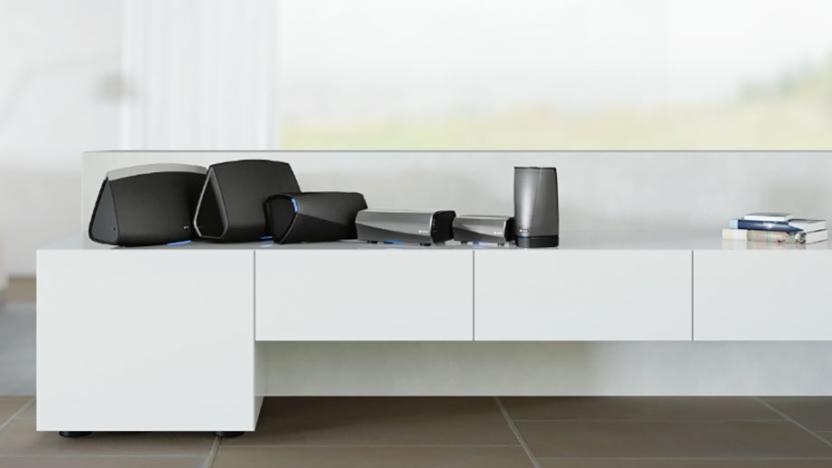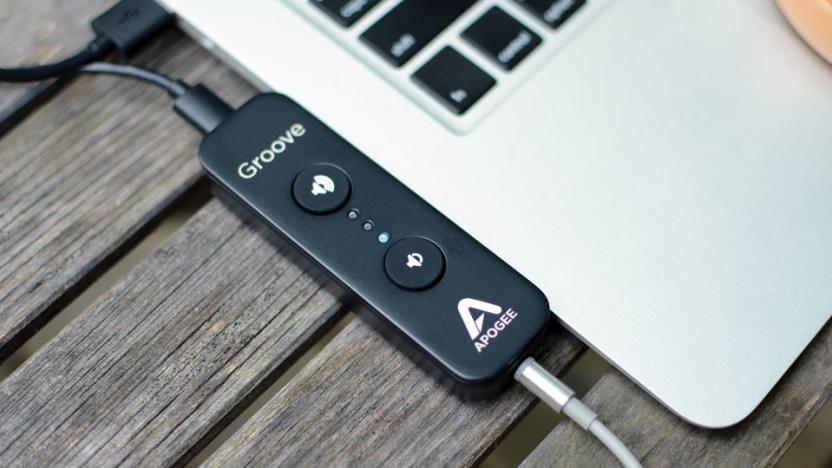amplifier
Latest

Fender's Mustang GT amps pack an overkill of digital options
Playing the electric guitar in a cover band can be complex. You need to be able to sound like a wide range of different guitar players, each with their own distinct sound -- much of which is based on their unique amplifier and effects profile. The Fender Mustang GT series of amplifiers, consisting of 40-, 100- and 200-watt models, aims to squeeze a range of classic Fender sounds into a single digital cabinet. Imagine being able to sound like Prince, AC/DC and Chic in quick succession onstage without having to change out any of your gear. That's the Mustang GT promise, and -- for the most part -- Fender succeeds. With a full-featured set of pre- and post-effects modules, customizable presets and a deep catalog of amplifier emulation available, Fender has made it pretty easy to sound however you want, provided you're OK with a solid-state sound rather than a tube-based one.

Blue's wireless Satellite headphones pack a built-in amp for $400
Blue announced its first wireless headphones back at CES, but now you can finally get your hands on a pair. The company's latest model, Satellite, has Bluetooth 4.1 and Apt-X to keep the wireless streaming from your go-to device going strong. To further enhance the high-quality audio, there's a built-in headphone amp. Similar to some of Blue's existing headphone models, you can turn that feature off to save battery or at times to you may not need it -- like when you're listening to podcasts.

Fender's new guitar amps can be fine-tuned from your phone
Fender first revealed its mobile software plans back in August of last year when the guitar maker's digital arm debuted a tuner app for iOS. In November, we learned the company had guitar amplifiers in the works that would wirelessly sync settings with its library of apps. Today, we finally meet the pieces of Fender connected guitar gear: the Mustang GT amps.

Blue's pricey planar magnetic headphones feature a built-in amp
Blue may be a company known more for its studio-grade and USB microphones, but in 2017 it's taking a deeper dive into headphones. After the 2014 introduction of Mo-Fi, a set of headphones with a built-in amplifier, the company released Lola last year. Although that second set didn't feature an amp, it did still offer Blue's rather unique hinged design cut out the added heft. At CES today, the company already took the wraps off of the wireless Satellite headphones and it also has two other models that are set to ship early this year.

Blue's first wireless headphones nix the cord, keep the built-in amp
Blue is a name most people associate with USB microphones for podcasting and desktop recording. But the brand has a stellar reputation for studio mics as well. Back in 2014, the company released its first set of headphones, Mo-Fi, which featured a built-in amp to drive high-quality sound. At a time when headphone jacks are becoming scarce, wired headphones are an increasingly tough sell. Against that backdrop, Blue has a wireless option it's debuting off at CES -- and it still features an amplifier to preserve top-notch audio quality even after nixing the cable.

Fender's guitar apps will sync wirelessly with its new amp
Fender revealed its plans for a suite of guitar apps back in August, but some of the software will also pair with one of the company's upcoming amps. According to Bloomberg, Fender has a new guitar amplifier in the works for 2017 that will connect to its apps wirelessly via Bluetooth. So far, the company's digital initiative has only released the Tune iOS app, but there are more options coming soon.

Denon outfits Heos speakers with Bluetooth and high-res audio
Denon debuted its Heos line of speakers nearly two years ago, a set of audio gear that looked to rival multi-room setups like Sonos and others. Now Denon is giving the speakers a bit of a boost by adding some new features. The new Heos lineup sports the same model names and exterior design as Series 1 that arrived back in 2014. However, what has changed is the addition of high-res audio and Bluetooth connectivity.

Panasonic is reviving Technics' legendary DJ turntables
Ask DJs about their favorite turntables and they'll frequently swear by Technics' SL-1200 -- even though it hasn't been made since 2007, the super-reliable deck is still the gold standard for vinyl spinners. If you're one of those enthusiasts, you'll be glad to hear that Panasonic is bringing Technics turntables back as part of a larger revival for the audio brand. Many of the details are still under wraps, but the turntable set will have a new direct-drive motor that should improve the audio quality. The gear won't show up until some point during Panasonic's next fiscal year (sometime between April 2016 and March 2017), but more development time is likely a good thing. After all, the SL-1200 thrives precisely because its makers were careful to preserve elements that worked well -- a rushed product could easily hurt more than it helps. Check out all the news from Berlin at our IFA 2015 hub.

Apogee Groove improves headphone audio, for a price
It's been awhile since I've spent much time with Apogee's audio gear. In my early Engadget days, I reviewed both the Jam and MiC, two portable recording accessories that turned the iPad into a tracking center for guitars, vocals and podcasts. Earlier this year, the company revealed the Groove, putting years of pro audio experience to work improving subpar headphone audio. The diminutive metal device sits comfortably between your go-to headphones and laptop, providing a massive sound boost despite being about as small as a pack of gum. So, what's the catch? Well, if you're familiar with Apogee, you know its gear isn't cheap. Does the Groove provide enough oomph to warrant its $300 price tag? That depends on your listening habits.

Alienware's got a massive $300 dock for your new graphics card
We know what you're thinking: What the hell is a "graphics amplifier"? (Some of you smartasses are probably also wondering if it goes to 11.) In fact, it is what it sounds like: The Amplifier, a new accessory from Alienware, is a big ol' shell that lives on your desk, with room for nearly any desktop-grade GPU (anything up to 375 watts). Once you get that set up, you plug the thing into your gaming laptop via a cable and boom, your notebook is suddenly running off a desktop-grade GPU, not the mobile one that came built inside the chassis. As a bonus, the Amplifier also has four powered USB ports, so you can also use this as a docking station for your keyboard, mouse, monitor, et cetera. And yes, that glowing Alienware head on the front has customizable lighting. Of course it does.

5 iPhone speaker amplifiers that you already own
The speakers on the iPhone are fine for text tones and chirps from Angry Birds, but they don't really fit the bill for high-quality music. If you don't have your headphones handy but still want to rock out to some booming tunes, give these household objects a try. They work like a megaphone for your music, and you'll be surprised by how much better your iPhone can sound. A mug The old standby, tossing your iPhone in a mug is the most common way people add some muscle to their iPhone's speakers. It's handy, and you probably have one on your desk right now. A measuring cup Thick glass measuring cups are just as good, if not better than a simple coffee mug. The plastic versions don't work nearly as well, so don't bother with those. Anything ceramic Ceramic pottery -- like an unused vase or planter -- will give add some serious "boom." You want to make sure the object you're using is at least as tall as your iPhone, as the effects aren't nearly as noticeable in a shallow bowl or dish. A Pringles can Don't toss that snack sleeve out once you've enjoyed its tasty contents, just slide your iPhone in and enjoy the sweet sounds of louder, more crisp musical notes. A drawer If you're really in a bind and don't have any of the above objects within reach, you may still be able to give your iPhone some amplification by using an empty drawer. Smaller drawers work better, and you'll want to make sure it's only open about half way. Oh, and don't try this if you have a bunch of junk in the drawer, because it'll kill any positive effects. [Photo credit: Heodeza]

Sony preps portable and integrated stereo amps for its High Resolution Audio series
Sony began catering to well-off audiophiles last month with its High Resolution Audio series, but it left out portable music fans and those with existing audio systems. The company is covering those gaps in its lineup this weekend. Its new PHA-2 (shown above) is billed as the first portable amplifier/DAC combo to support "virtually every" studio-grade audio format, including 24-bit/192KHz PCM files; it can handle digital audio from PCs and iOS devices, as well as analog audio for other sources. Listeners who are primarily stationary, meanwhile, may want the TA-A1ES integrated stereo amp (seen after the break). The audio companion puts a strong emphasis on reducing unwanted noise through a specially-designed chassis, gain volume control and transistors that minimize sound channel variations. The TA-A1ES is shipping this month for a hefty $1,999, but you'll have to be patient for the PHA-2 -- the portable amp won't arrive until March, when it will cost $600.

Infinite Crisis amplifier set preview lands with October update
October's Infinite Crisis update brings a small preview of big changes. Turbine is adding an "early version" of the game's augmentation system, an addition that should help players to learn the basics of character enhancement before the full system goes live. Augmentation is accomplished via amplifier sets, which are collections of items designed to enhance champions in a variety of ways depending on role and play style. Each amplifier set is composed of four augments and three mods. Augments enhance stats, while mods enhance artifacts. Every amplifier item will be associated with a brand; each brand benefits specific champion roles. While the complete amplifier system will allow players to build their own sets from scratch, the sets introduced this month are package deals. Turbine has plans to release hundreds of augments and mods as Infinite Crisis grows. Check out the video after the jump for a quick look at amplifiers, or hit up the official post for a detailed breakdown.

The little silicone amplifier that sort of, kind of could
While shopping at the dollar store, my daughter and I stumbled across one of these: a silicone iPhone amplifier. For a buck? She looked at me, I looked at her. She won. The little amplifier came home with us for a test run. My tiny battery speaker set has been a subject of dispute between us. She borrows it; she blasts horrific music; she forgets to switch it off; she goes through batteries like a ravenous bear goes through a dumpster. We decided to see if a power-free US$1 amplifier would solve the problem. You stick the phone into the unit -- it's a bit of a squeeze, and you can't use a bumper or a case with it. It's important that the device is fully inserted because the horn depends on the placement of the phone's speaker. Turns out the horn is also dependent on the placement of the phone's listener as well. Because although the amplifier does what it advertises, the cone is such that it does a pretty poor job of projecting to an entire room -- even a small girl's bedroom. I'm not saying the device is bad -- it's actually pretty good at projection, but that projection is unsurprisingly directional and more suitable for aiming at particular people than covering an entire space. So who will this device be useful for? It's really hard to say. Nearly every scenario I could brainstorm would be better solved with either headphones or a normal docked speaker system. Maybe it would work well in a hotel room? For a modest sound boost? What these little things have going for them is that 1) they're cute as buttons and 2) super cheap. Even if your dollar store doesn't have one, you can pick one up shipped off Amazon for under three bucks. In the end, I'm glad we didn't pay retail for a device that's going to end up being donated to Goodwill or gather dust in a drawer.

Sennheiser's HDVD 800 digital headphone amp now available in the US for $2,000
Analog may be king for audiophiles, but digital is the future, friends, and Sennheiser knows it. That's why it built the HDVD 800 digital headphone amplifier to improve the sound of your digital tunes, and now stateside listeners can finally get their mitts on the thing. That's right, folks, a year after it was revealed across the pond alongside its analog brother, Senn's digital offering's finally available in the US for just a nickel less than two grand. Folks looking to part with the necessary cash to improve their listening pleasure can do so at the company's online storefront linked below.

Belkin's Thunderstorm case cranks your iPad to 11
In my office I tend to rock out to a 300-watt stereo system. When I go to wash dishes and have to use my iPad's native speaker, well, there's no comparison. Belkin's Thunderstorm case won't crank up to the level of a really large stereo, but it is loud enough to punch through very noisy environments with ease. At CES I tried one on the show floor where the sound level (according to my iPhone) was close to 100 decibels and the Thunderstorm was not only loud enough to hear, the audio actually sounded good. It's not perfect, however, as I'll explain below. It also retails for US$199, so this is not a budget case or speaker. Design Like any iPad case that surrounds the iPad, the Thunderstorm cradles your iPad in a large plastic shell and provides a cover somewhat like Apple's Smart Cover -- but with no magnetic actuation of the iPad itself, like the Smart Cover. The iPad slides into the case, and is secured by a 30-pin dock connection which clicks into place, and provides the power and audio output needed. Of course you simply can't get around physics, so the drivers for the Thunderbolt are heavy. The case is heavy. Your iPad inside will make all of this very heavy, but this is not a case for casual use if you tend to mostly read iBooks on your iPad. This case is designed to stand up and be loud. There's a shockingly small speaker port on the front, along with a small light under the grill to indicate when the charger (included) is plugged in. The case uses ports to enhance the sound, much as a full size speaker would, and they work very well. I had a little trouble with the charger at first, until I realized there's just a delay from when you plug it in to when the iPad begins to charge. Still, it is a wall wart and not the most convenient AC adapter to carry around. I wouldn't say it charges slowly, but it is not a fast charge by any means. A bigger problem in the cover flap. It's one of those origami-style flaps that pinches together to provide a "stand" for viewing the iPad mostly upright. You can roll up the case like Apple's cover, which provides a more upright angle, or fold the case into a bit of a triangle, putting the iPad at almost 45 degrees. That viewing angle is a bit odd, as I felt it leaned back a little far, and you cannot adjust it, but there's the other option, which I felt isn't as stable. The good news is the flap, when folded as a support, is very sturdy and I never really had it fall down. The bad news is it is loosely secured at the hinge, and if you're used to the relatively strong magnets on the Smart Cover, you will find these magnets aren't as strong. Often while closing the flap I would yank the cover off -- and I'm a wimp. There are pass-through (mechanical) buttons for power, rotation and volume, plus a large hole for headphones and even a speaker vent at the bottom where the iPad's speaker resides. Functionality It's loud. Really loud. Without exception, when I would demonstrate the volume on this thing their eyebrows would raise and they would say "wow." You won't believe so much sound can come from a small package -- unless you've used a Bose Smartwave, which is similar in a way. Loudness is the distinguishing feature here, however. This is not a protective case, and it's not designed to do much more than cradle your iPad and make it much louder. Luckily it does that job admirably. It's worth noting that audio quality does not suffer at the hands of volume, and even at the highest setting the highs were crystal clear while the bass punched through loud environments admirably. There's also a companion app which does boring stuff like handle registration and check firmware, but it also allows you to control the stereo separation. That's a neat trick, but unless you have the device pointed at your face, you lose the spread pretty quickly. Sound, again, is bound by the laws of physics. Conclusion If you need a very loud speaker for the iPad but don't want something huge like a dock or external stereo, and you want this speaker embedded in a case, the Thunderstorm is perfect. Belkin's Thunderstorm is the loudest iPad case I've ever heard, and the audio quality doesn't suffer as you crank up the volume. The price, at $199, may turn off some customers, but if you compare to large boombox docks (like JBL's OnStage) it's pretty reasonable. I feel that you're getting your money's worth if you frequently need your iPad to be heard in loud environments or you just want ear-blasting noise from your tablet.

Daily Update for February 25, 2013
It's the TUAW Daily Update, your source for Apple news in a convenient audio format. You'll get all the top Apple stories of the day in three to five minutes for a quick review of what's happening in the Apple world. You can listen to today's Apple stories by clicking the inline player (requires Flash) or the non-Flash link below. To subscribe to the podcast for daily listening through iTunes, click here. No Flash? Click here to listen. Subscribe via RSS

Brass instruments make custom iPad amplifiers
Speaker and amplifier choice is a personal thing, with some focusing on sound quality and others preferring form over function. If you are looking for something unique, then you should check out this Analog Tele-Phonographer spotted by Boing Boing and crafted by Christopher Locke. Each unit is handmade from salvaged trumpets and other brass instruments. It's technically an amplifier so it doesn't need any external power source to fill a small room with music. Because of how they are made, each one is unique both in appearance and performance. [Via Boing Boing]

Roland Cube Lite mini amplifier allows you to control guitar licks, aux input independently (video)
At the start of NAMM 2013, Roland announced two new models in its Cube line and an iOS app to complete the trio. Both the Cube Lite and Cube Lite Monitor are on display in all of their dual-connecting glory, but we're far more interested in the former for its guitar amp wares. The 10W compact unit touts built-in JC Clean, Crunch and Extreme tones alongside Chorus and Reverb controls. We were pleasantly surprised with how well these on-board sounds came across at the strings of a Stratocaster during the booth demos we witnessed. Usually included presets can be really hit or miss, but these are quite serviceable -- especially in a portable unit. As you might expect, all of the usual controls are here including volume, treble, bass and drive and the requisite 1/4-inch input graces the backside. That's all quite nice, but the real story here is the iOS software and aux connectivity. That iOS app, Cube Jam, allows you to record and play along with tunes from your iDevice and connects via the i-Cube Link stereo auxiliary input from the headphone jack of a slate or handset. We were a bit disappointed that the connection didn't come at the hands of a 30-pin jack or Lightning port, but overall the unit worked quite nicely in our limited time with it. The separate volume control for the aux port is quite nice and allows the user to adjust levels of the amp and the accompanying track independently to keep things just so. We'd surmize that you'd be able to connect an Android, BB10 or WP8 device for playback, if you're willing give up the Cube Jam software. Cube Lite also requires a tethered power supply and doesn't support Bluetooth connectivity like we saw on the iLoud from IK Multimedia. If you don't have a need for the guitar functionality, the Cube Lite Monitor wields the same 1/8-inch input, but offers stereo 1/4-inch jacks instead and tosses the in-built tones. Head on past the break for a quick tour and a closer look awaits in the gallery just below.

Sennheiser unveils HDVA 600 analog headphone amp, asks for $1,600
Along with a few IFA 2012 announcements, Sennheiser peeled back the wraps from its HDVA 600 headphone amp, an analog flavor of the previously unveiled HDVD 800. Like its sibling, the freshly revealed hardware sports a glass panel for peeking at its innards and an anodized aluminum exterior, but leaves the digital inputs behind. While the 800 carries a hefty $2,000 price tag, the 600 will set customers back a smaller -- but still substantial -- sum of $1,600. Both units are tailored for the likes of Senn's flagship HD 800 headphones, so they should easily be able to drive cans that require up to 300-ohms. The pair won't be available in the US until later this fall, but in the meantime, you can breeze past the break for specs and more details in the press release.









